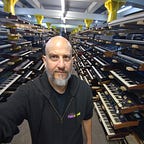10 Days. 10 Stories. Part 2–2011
Projects. Projects. Projects! Nothing like projects to get one fired up, and we certainly needed the extra heat to deal with the bitter winter cold of Alberta, Canada. First destination for 2011 was Edmonton to kick off an infrastructure project for hosting a new upstream oil & gas web application stack.
We got ourselves and our client into the brave new world of virtual machines running on VMWare ESXi. It was pretty cool to be able to build machine images at our home base in Grenoble and deploy them over secured management VPNs to datacenters in Calgary, Edmonton & Paris. This project also saw us leveraging the power of NGINX for frontend reverse proxy and content acceleration duties. Unfortunately the commercial web application software package selected by our client suffered from some horrible performance limitations due to the underlying Microsoft ISAPI. We were able to obtain a 50% performance boost by implementing SSL offload and judicious use of HTTP request pipelining in NGINX.
The infrastructure solution also included a secured management network using a bastion jump host and internal VLANs for systems administration. In fact this original design was the basis for the fieldcloud service network which is still in production today.
In June 2011, we deployed a beta test production environment colocated in the Telus IDC in Calgary. Our client had wanted to have the application hosted within their M2M field connectivity vendor's space to ensure minimal latency between the vendor's middleware stack and the new web application's backend. However, the vendor wasn't too happy about sharing Internet bandwidth for the web application front end and aggressively rate shaped the traffic. So we ended up switching over to fieldcloud's service network in Paris which dramatically boosted performance and ended up providing a good experience to beta test users worldwide. Sadly, the beta test was not successful due to limitations in the commercial software package and the solution was retired at the end of 2011.
Meanwhile, another project was gaining momentum. This was our first foray into edge computing. Based on our experiences in Angola the previous year, we knew that shrinking the field hardware footprint was very important for remote offshore platforms, especially those with limited onboard power (i.e. solar panels with DC only supply) and physical space.
We took an TS7800 industrial single board computer from Technologic Systems, added dual SSDs running in a RAID1 mirror configuration and added a second Ethernet port. Built a custom Debian Linux OS and wrote device drivers to manage an Inmarsat BGAN satellite terminal.
We met up with a cool UK based electronic enclosure specialist, Lincoln Binns who built a really neat, ruggedized housing for our prototype ns-box.
Next stop was Kuala Lumpur, Malaysia to plan the very first deployment of new generation edge computing and data delivery for the oilfield.
The real fun part of the project was in Labuan, a tiny island off the north coast of Borneo. We needed to retrofit an existing well-site communications enclosure with our ns-box prototype, rewiring the entire assembly, testing the end to end system and training a team of field engineers responsible for the offshore installation.
The solution deployed offshore allowed our client and their client to not only monitor subsurface pressure & temperature but also to perform some advanced pressure transient analytics to help with future production optimization.
We learned a lot about designing small form factor edge computing appliances for harsh environments. The prototype worked quite well but was based on an older ARM9 system on chip running at 500MHz with only 128MB RAM. We managed to leverage the fast SSD RAID1 storage to offset the limited RAM but it was clear that we could improve performance and reliability. Also, the prototype was a bit clunky inside with 2.5" SSDs and multiple printed circuit boards (including a USB to Ethernet adapter). This led to fieldcloud's first proper product development project to build the real ns-box.
10 Days. 10 Stories. A special feature celebrating fieldcloud’s adventure over the last decade and how we became the company we are today.
